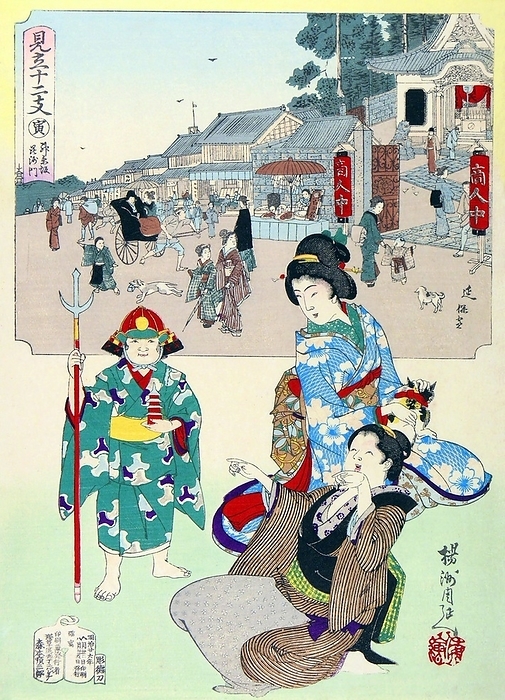
ED
Japan: Tiger, Kagurazaka Bishamon. Ukiyo-e woodblock print by (Toyohara) Yoshu Chikanobu (1838-1912)
A boy is dressed like the Buddhist Guardian King Bishamonten, holding a trident and wooden pagoda (that represents the relics of the historical Buddha). The boy's mother holds a calico cat (a 'tiger' symbol) while the family servant giggles and points at her young master. The inset shows a temple hall dedicated to Bishamonten, whose name appears on the red paper lantern inside the door.<br/><br/>The inset shows a temple hall dedicated to Bishamonten, whose name appears on the red paper lantern inside the door.
The gateway has modern wrought iron panels affixed to a traditional stone gatepost, and a rickshaw is being pulled down the street - all indications of the However, the stores seem to be traditional buildings, and the merchants have contributed the red paper lanterns that flank the gate, reading 'mid-merchants'. However, the stores seem to be traditional buildings, and the merchants have contributed the red paper lanterns that flank the gate, reading 'mid-merchants' (shonai chu) association (1893). <br/><br/>
Toyohara Chikanobu (1838-1912), better known to his contemporaries as Yōshū Chikanobu, was a prolific woodblock artist of Japan's Meiji period. His works capture the transition from the age of the samurai to Meiji modernity.<br/><br/><br/>The work of Toyohara Chikanobu (1838-1912), better known to his contemporaries as Yōshū Chikanobu, was a prolific woodblock artist of Japan's Meiji period.
In 1875 (Meiji 8), he decided to try to make a living as an artist. He travelled to Tokyo. He found work as an artist for the Kaishin Shimbun. In his younger days, he had studied the Kanō school of painting; but his interest was drawn to ukiyo-e.<br/><br/>In 1875 (Meiji 8), he decided to try to make a living as an artist.
Like many ukiyo-e artists, Chikanobu turned his attention towards a great variety of subjects. As well as a number of the other artists of this period, he too portrayed kabuki actors in character, and is well-known for his impression. As well as a number of the other artists of this period, he too portrayed kabuki actors in character, and is well-known for his impressions of the mie (formal pose) of kabuki productions.<br/><br/><br/>These are the first two works of the series.
Chikanobu was known as a master of bijinga, images of beautiful women, and for illustrating changes in women's fashion, including both traditional and Western clothing. His work illustrated the changes in coiffures and make-up across time.
Details
ID
177779511
Collection
License type
Editorial
Photographer
Creation date
05-01-2022
Contact Aflo for all commercial uses.

More
Top Categories
